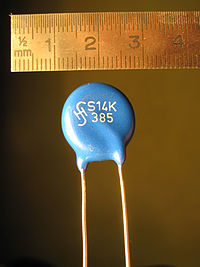
Photo from wikipedia
Abstract The UV photocurrent response of thin films of wide bandgap semiconductors such as zinc oxide (ZnO) can be applied to a great number of electronic devices aiming applications in… Click to show full abstract
Abstract The UV photocurrent response of thin films of wide bandgap semiconductors such as zinc oxide (ZnO) can be applied to a great number of electronic devices aiming applications in environmental sensing or UV-detection. Electronic devices like thin-film transistors or Schottky diodes commonly present multiple parameters of electrical characteristic, which can be beneficially exploited to provide more information than sensors based on purely resistive or capacitive response. We manufactured Schottky diodes using spray-coated ZnO and poly(3,4-ethylenedioxythiophene)-poly(styrenesulfonate) (PEDOT:PSS) as an easy, simple and low-cost method for producing multiparametric UV-photodetectors. The diode parameters presented rectification ratios (RR) as high as 104 and ideality factors as low as 1.3, and their characteristic curves were analyzed by Cheung's method to determine the effect of UV irradiation on the ideality factor, series resistance and Schottky barrier height. The study of the photocurrent response from spray-coated ZnO films as a function of geometric parameters and UV intensity demonstrated a transition from bimolecular to monomolecular recombination process at higher irradiance values, as a result of the adsorption/desorption dynamics of molecular oxygen at the semiconductor/air interface.
Journal Title: Materials Science in Semiconductor Processing
Year Published: 2021
Link to full text (if available)
Share on Social Media: Sign Up to like & get
recommendations!